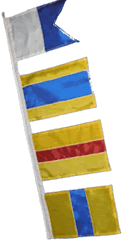
When any swashes they can find have been thoroughly buckled, or indeed buckles swashed, swashbucklers might hear the exclamation/order ‘splice the mainbrace!’. I’ve often wondered what a mainbrace was and how you would splice one. So I decided to find out.
It turns out that nowadays the order ‘splice the mainbrace’ has nothing to do with the splicing of braces, main or otherwise, but is in fact an order to issue the crew of a navel vessel with an extra ration of rum or grog.
Originally the order referred to the repairing of the mainbrace, the largest of the lines or ropes that control the angle of the yards on a sailing ship. This was a difficult but essential task, as a ship could not be steered without a mainbrace, which was a prime target during battles, and it was customary for an extra ration of rum to be issued after the mainbrace had been successfully spliced. The order continued to be used after sailing ships were no longer used, but referred just to the extra rum ration rather than to the actual mainbrace splicing, and tended to be made after after victory in battle, or on the occasion of a change of a monarch, a royal birth or wedding, or an inspection of the fleet. [source]
The flags on the right are the maritime signal flags for the order ‘splice the mainbrace’.
The word splice, meaning ‘to join (ropes, cables, lines, etc.) by untwisting and interweaving the strands of the ends so as to form one continuous length’ comes from the Middle Dutch word splissen, the origins of which are uncertain [source].
Interesting that a Marlinspike, which anyone who would splice a mainbrace would need, also has it’s etymological roots in Middle Dutch. I wonder how much of our sailing terminology comes from Dutch?
Do you know if this is peculiar to American/British English or what?
I’m not a specialist when it comes to naval terms, but my mother’s tongue being Dutch, I do know there’s many a naval word in Dutch that has indeed been adopted in English. I’m thinking of words like sloop (< sloep), keel (< kiel), keelhauling (< kielhalen), buoy (< boei) and maelstrom (< maalstroom), even though I’m not sure this last word has indeed been borrowed from Dutch and not some Scandinavian language.
A few more nautical terms from Dutch:
– yacht – from Early Modern Dutch jaght (jacht in modern Dutch) – jaghtschip (“ship for chasing”), light sailing vessels, fast piratical ship
– skipper – from Middle Dutch or Middle Low German schipper
– deck – from Middle Dutch dek (roof, covering, cloak, pretext)
– dock – from Early Modern Dutch docke (dok in modern Dutch)
– freebooter – from Dutch vrijbuiter (privateer, pirate, robber)
– avast – probably from Dutch hou’vast (hold fast)
Maelstrom comes from the early modern Dutch word maelstrom (maalstroom in modern Dutch), which means “whirlpool”, from malen (to grind, to whirl round) and stroom (stream).
I’m almost finished the Patrick O’Brian series of naval novels. They are full of wonderful 18th-19th century naval terms that have made their way into modern English, e.g. taken aback, main stay, the bitter end, by and large, etc. It seems even in the time of the Napoleonic wars ‘splice the mainbrace’ meant breaking out the grog.
Grog is from the nickname of Admiral Vernon – Old Grogram – who mixed lemon juice with the 1/2 pint a day rum ration to prevent scurvy in 1740. The mix of rum, lemon juice, brown sugar and water came to be known as ‘Grog’. The name Grogram was from the grogram boatcloak he wore. From: Blake, N & Lawrence, R. The Illustrated Companion to Nelson’s Navy. London: Chatham, 1999.
“Splice the main brace,” is Miss Marple’s order to the steward for him to serve champagne to the officers on the ship she is inspecting in “Murder Ahoy”.